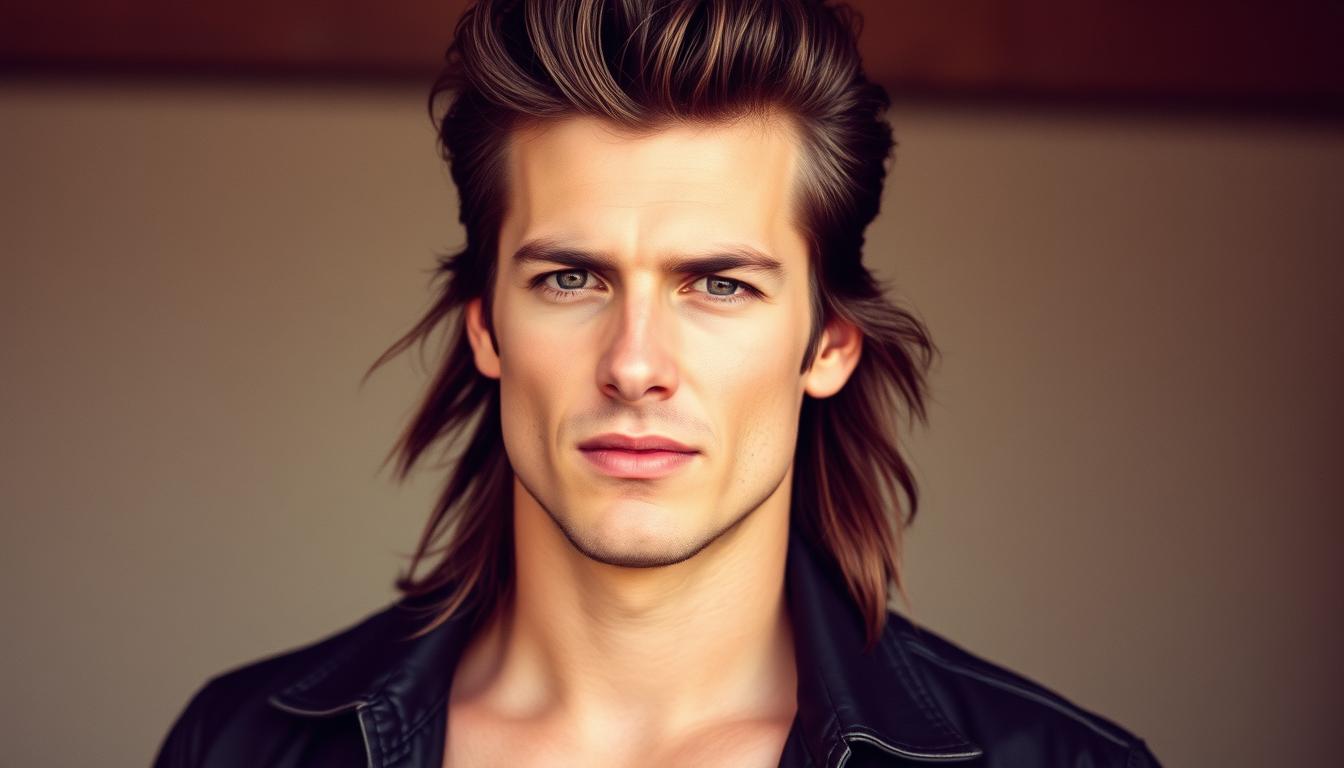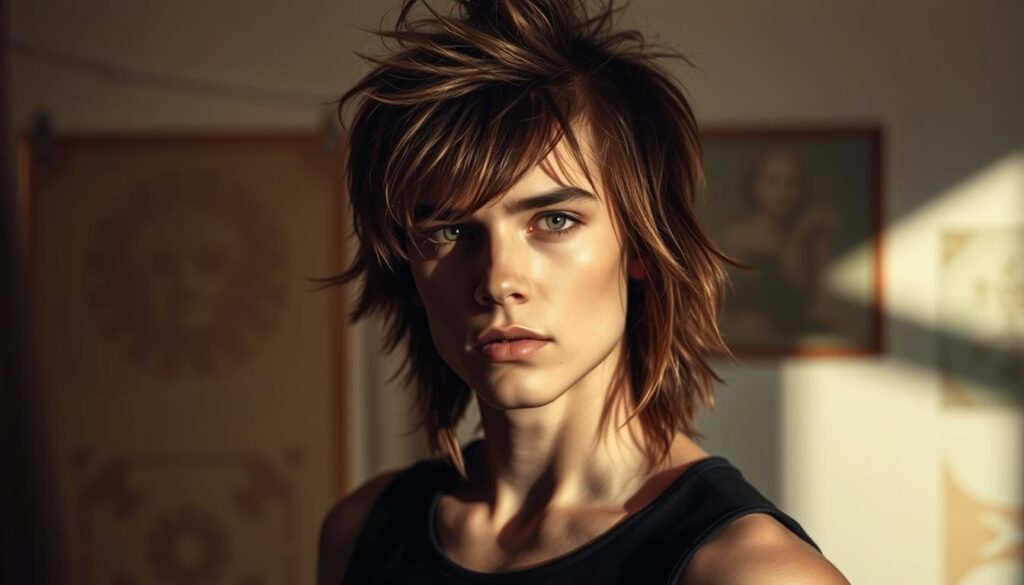
What if the most misunderstood hairstyle of the last century is now your secret weapon for standing out? Once dismissed as a relic of the past, this bold iconic style has stormed back into fashion with a rebellious edge that defies expectations.
Today’s versions blend sharp, tailored finishes with untamed creativity. Whether you prefer a subtle taper or dramatic contrast, the modern interpretation adapts to hair textures and personal tastes. It’s not just a look—it’s a statement of confidence.
The resurgence gained momentum as more people embraced self-expression post-2020. From athletes to musicians, influencers have redefined this silhouette, proving its versatility across professions and lifestyles. You’ll find variations that work with curls, straight strands, or even thinning patterns.
Key Takeaways
- The modern mullet merges vintage inspiration with contemporary techniques for a fresh appeal.
- Post-pandemic shifts in grooming habits fueled its popularity as men experimented with longer styles.
- Customization options include fades, lengths, and textures to suit diverse preferences.
- This cut complements various face shapes while offering low-maintenance versatility.
- Celebrity endorsements and cultural nostalgia have solidified its mainstream comeback.
Introduction to the Retro Mullet Revival

The fusion of rebellion and sophistication has never looked this sharp. Once a badge of rockstar audacity, this iconic style now bridges generations through its dual personality – polished enough for boardrooms yet wild enough for festival stages.
What Makes the Mullet Iconic?
Born from 1970s counterculture, the classic mullet became shorthand for defiance. David Bowie’s zigzagged version screamed artistic freedom, while Billy Ray Cyrus turned it into a crossover hit. Its magic lies in duality: {{the}} layers frame the face like a corporate trim, while cascading lengths whisper adventure.
Originally favored by blue-collar workers, this hairstyle crossed into mainstream fashion through sports legends and metal bands. Today’s versions ditch the “hillbilly” stigma, blending textured fades with artful asymmetry. You’re not just growing hair – you’re curating a legacy.
The Allure of Business in the Front, Party in the Back
Why does this philosophy click? It lets you code-switch visually. Crisp bangs and side parts say “reliable,” while untamed rear layers shout “unpredictable.” During 2020 lockdowns, many discovered its secret: low upkeep with maximum attitude.
Modern iterations use texturizing sprays instead of hairspray, creating lived-in grit rather than helmet-like stiffness. Whether you’re a barista or CEO, it’s about controlled chaos – proof that rules were made to be bent, not broken.
History and Evolution of the Mullet Hairstyle
![]()
Long before it became a cultural lightning rod, variations of this bold hairstyle appeared in ancient carvings. Egyptian pharaohs and Roman soldiers sported shorter front layers with longer back sections—practical for combat yet signaling status.
From Vintage Roots to Modern Trends
The 1970s reimagined the cut as a rebel’s uniform. By the 1990s, the Beastie Boys’ “Mullet Head” turned it into a technical blueprint. Their formula? A #1 clipper on the sides, #6 on top, and untouched lengths at the back.
Regional twists added flair. Australians perfected the “skullet” for rugged appeal, while Americans embraced the voluminous “Kentucky waterfall.” European versions leaned into asymmetry, blending punk aesthetics with precision.
| Era | Cultural Influence | Key Features |
|---|---|---|
| Ancient Times | Egyptian/Roman symbolism | Short front, long back for utility |
| 1980s | Rock & metal subcultures | Extreme lengths, teased textures |
| 2020s | Barbering innovation | Fades, layered texture, low maintenance |
Today’s versions ditch outdated stereotypes. Barbers use thinning shears and sea salt sprays to create lived-in grit. It’s no longer just a style—it’s a canvas for self-expression across professions and generations.
Trending Modern Mullet Styles
Gone are the days when bold styles demanded compromise. Today’s versions balance sharp professionalism with untamed creativity, offering structured yet rebellious options for every personality.
Refined Contrast: Sleek Front, Wild Back
The modern mullet haircut reimagines tradition with subtlety. Instead of jarring contrasts, barbers use blended tapering on the sides to maintain office-ready polish. Textured layers at the crown add volume, while the back flows freely—think “boardroom by day, concert by night.”
For those craving drama, the long mullet extends the rear section into cascading waves. Pair it with disconnected fades for a silhouette that turns heads without shouting for attention.
Fusion Cuts: Where Edge Meets Precision
Taper fades have become the secret weapon for contemporary updates. A mullet fade might feature:
- Low fade: Gentle transition above the ears
- Mid fade: Bold contrast starting at temple level
- High fade: Dramatic shift near the parietal ridge
Want to amplify the edge? The mohawk-inspired version keeps a thick central strip from forehead to nape, flanked by skin-tight sides. It’s rebellion with a ruler—every millimeter calculated.
“Today’s tools let us sculpt dimensions you couldn’t achieve in the ‘80s. Razor fades meet texturizing shears for organic movement.”
Whether you choose subtlety or shock value, these updated approaches ditch outdated stereotypes. The key lies in customized proportions that flatter your features while shouting your individuality.
Styling Tips for an Iconic Look
Building a standout style requires more than scissors and attitude. Strategic product use and technique transform basic cuts into head-turning statements. Let’s break down the essentials for maximizing volume and texture.
Using Volumizing Shampoo and Conditioner
Start with clean, nourished strands. Volumizing formulas lift roots without weighing down lengths. Apply shampoo to your scalp using circular motions to stimulate blood flow. Rinse thoroughly, then condition mid-lengths to ends only.
For extra body, try this trick: Blow-dry while flipping your head upside down. The heat locks in lift while creating natural movement. Fine or thinning types benefit from root-boosting sprays applied before drying.
Mastering Texturizing Techniques
Sea salt spray works best on damp hair. Scrunch sections upward to create beachy separation. For structured looks, apply matte clay to dry strands, working from back to front. Twist random pieces for organic grit.
| Product | Purpose | Application |
|---|---|---|
| Texturizing Powder | Adds grip & volume | Rub into roots, then tousle |
| Styling Clay | Flexible definition | Warm between palms first |
| Sea Salt Spray | Beachy separation | Spritz on damp hair |
Finish with a cold air blast from your dryer. This seals the style while reducing frizz. Remember: Layering products creates lasting dimension. Start light – you can always add more.
Face Shape, Hair Type, and Personalized Options
Your facial structure holds the blueprint for choosing a style that enhances your natural features. The right proportions balance angular jawlines, soften round contours, or add definition where needed. Let’s explore how to match your unique characteristics with modern variations.
Mapping Features to Flattering Designs
Oval face shapes enjoy the most flexibility. Classic tapered sides with longer backs create harmony without overwhelming balanced proportions. For square jaws, textured layers soften edges—try disconnected fades that draw eyes upward.
Round faces benefit from vertical lines. Keep sides tight while extending the back length to elongate your silhouette. Angular fringe adds sharpness to counteract circular curves. Heart-shaped types should focus on balancing wider foreheads with fuller nape areas.
| Face Structure | Key Adjustment | Styling Tip |
|---|---|---|
| Square | Soften jaw definition | Messy texture with side-swept fringe |
| Round | Create vertical length | High-contrast fade + pointed back |
| Heart | Add lower-face volume | Layered nape with tapered temples |
Hair density determines what your strands can handle. Fine straight types thrive in cropped versions with added root lift. Thick curly textures embrace dramatic lengths—use thinning shears to reduce bulk without losing shape.
Combine these insights with your daily routine. Office workers might prefer polished tops with subtle rear graduation. Creative professionals can amplify edge with razor-sharp fades and bold product contrasts. Your look should reflect both personal flair and practical needs.
Celebrity and Influencer Mullet Inspirations
Stars have always shaped grooming trends, but today’s icons prove this hairstyle works beyond red carpets. From stadiums to concert stages, bold personalities showcase how to wear the look with modern flair.
Rock Legends and Sports Icons
David Bowie’s lightning-bolt zigzag mullet defined 1970s glam rock rebellion. Today, athletes like Virat Kohli pair tapered fades with textured backs for IPL-ready edge. Rugby star Ryan Papenhuyzen keeps his version rugged yet refined – proof that style survives tackles and sweat.
Hollywood’s influence shines through Jeremy Renner’s sharp look as Hawkeye, blending superhero polish with untamed lengths. Meanwhile, Harry Styles’ tousled interpretation bridges music and fashion, using sea salt spray for effortless separation.
| Profession | Signature Feature | Maintenance Level |
|---|---|---|
| Athletes | High fades + sweat-resistant products | Low |
| Musicians | Textured layers + bold accessories | Medium |
| Actors | Precision cuts + matte finishes | High |
Global variations reveal cultural twists. Soccer star Héctor Bellerín rocks a middle-part European version, while Neymar Jr. amps up Brazilian flair with disconnected sides. These adaptations prove the hairstyle morphs to fit any personality or profession.
To channel these looks, identify elements matching your lifestyle. Office workers might borrow Patrick Mahomes’ clean fade, while creatives could emulate Jaydan Armour’s curly volume. Your hair becomes the canvas – mix celebrity inspiration with personal authenticity.
Essential Mullet Haircut Men Guide
Achieving the perfect balance between sharp edges and flowing lengths starts with precise technique. This step-by-step approach ensures your style stays fresh while honoring its rebellious roots.
Crafting Your Signature Style
Begin by sectioning your strands into three zones: front, sides, and back. Use clips to isolate each area. For the sides, start with clippers using a #2 guard, gradually blending upward. Switch to scissors for the crown, cutting vertically to maintain texture.
Focus on the back section last. Trim ends at an angle to preserve length while removing bulk. Thinning shears soften harsh lines, creating seamless transitions between lengths. Finish with matte paste rubbed between palms and scrunched through strands for natural separation.
Choose tools wisely. A quality razor comb tackles thick textures, while spray bottles with fine mist control dampness. For fades, adjust clipper guards (1-4) based on desired contrast. Remember: less product creates lived-in grit perfect for daily wear.
This method adapts to any face shape or hair type. Keep sides tight for rounder faces or add volume at the crown to elongate features. The key lies in customization – your signature blend of polish and freedom.
